

A Teacher's Guide to Differentiating Instruction. Introduction Does effectively teaching 30 students in one classroom require teachers to develop 30 lessons, one tailor-made for each student?
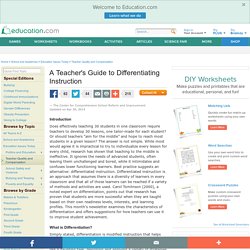
Or should teachers “aim for the middle” and hope to reach most students in a given lesson? The answer is not simple. While most would agree it is impractical to try to individualize every lesson for every child, research has shown that teaching to the middle is ineffective. It ignores the needs of advanced students, often leaving them unchallenged and bored, while it intimidates and confuses lower functioning learners.
What is Differentiation? Simply stated, differentiation is modified instruction that helps students with diverse academic needs and learning styles master the same challenging academic content. How to Start Four planning steps set the stage for effective differentiated instruction. Vary Materials Nonfiction and fiction, written at a variety of reading levels. Vary Process Vary Assessment Conclusion References Good, M. View Full Article. Methods of Differentiation in the Classroom. It’s a term that every teacher has heard during their training: differentiation.
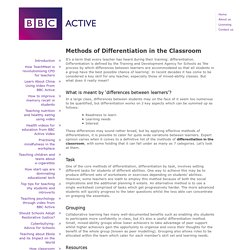
Differentiation is defined by the Training and Development Agency for Schools as ‘the process by which differences between learners are accommodated so that all students in a group have the best possible chance of learning’. In recent decades it has come to be considered a key skill for any teacher, especially those of mixed-ability classes. But what does it really mean? What is meant by ‘differences between learners’? In a large class, differences between students may on the face of it seem too numerous to be quantified, but differentiation works on 3 key aspects which can be summed up as follows: Readiness to learn Learning needs Interest These differences may sound rather broad, but by applying effective methods of differentiation, it is possible to cater for quite wide variations between learners.
Task Grouping Resources Pace Outcome Dialogue and support Assessment. Twelve Active Learning Strategies. Example 1 Example 1 Explanation In order for students to learn effectively, they must make connections between what they already know (prior knowledge) and new content to which they're exposed.
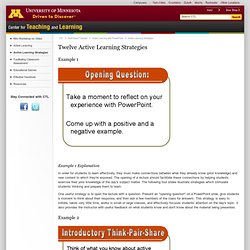
The opening of a lecture should facilitate these connections by helping students exercise their prior knowledge of the day's subject matter. Some Basic Active Learning Strategies. Engaging students in individual or small group activities–pairs or trios especially–is a low-risk strategy that ensures the participation of all.
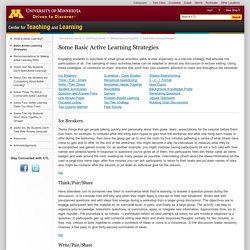
The sampling of basic activities below can be adapted to almost any discussion or lecture setting. Using these strategies, or variations on them, ensures that you'll hold your students' attention in class and throughout the semester. Ice Breakers Those things that get people talking quickly and personally about their goals, fears, expectations for the session before them. Ask them, for example, to consider what one thing each hopes to gain from the workshop and what one thing each hopes to offer during the workshop, then have the group get up to rove the room for five minutes gathering a sense of what others have come to gain and to offer. Top Think/Pair/Share Write/Pair/Share The format for this strategy is identical to the think-pair-share, except that students process the question asked of them by writing about it rather than reflecting.
Top. What is 4MAT? Helping dyslexic children within the classroom. © 2000, Patricia Hodge Dip.spld(dyslexia) Proficient reading is an essential tool for learning a large part of the subject matter taught at school.
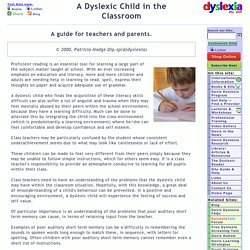
With an ever increasing emphasis on education and literacy, more and more children and adults are needing help in learning to read, spell, express their thoughts on paper and acquire adequate use of grammar. A dyslexic child who finds the acquisition of these literacy skills difficult can also suffer a lot of anguish and trauma when they may feel mentally abused by their peers within the school environment, because they have a learning difficulty. Much can be done to alleviate this by integrating the child into the class environment (which is predominantly a learning environment) where he/she can feel comfortable and develop confidence and self esteem. Class teachers may be particularly confused by the student whose consistent underachievement seems due to what may look like carelessness or lack of effort.
In the class: Reading: Spelling: